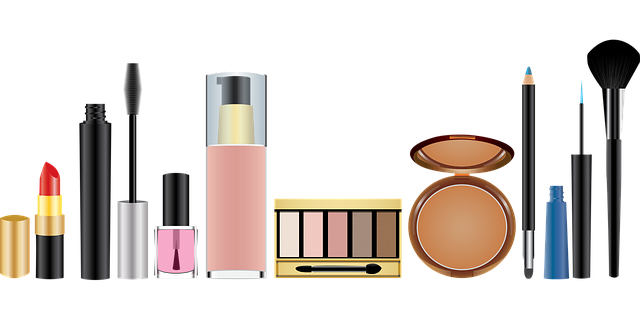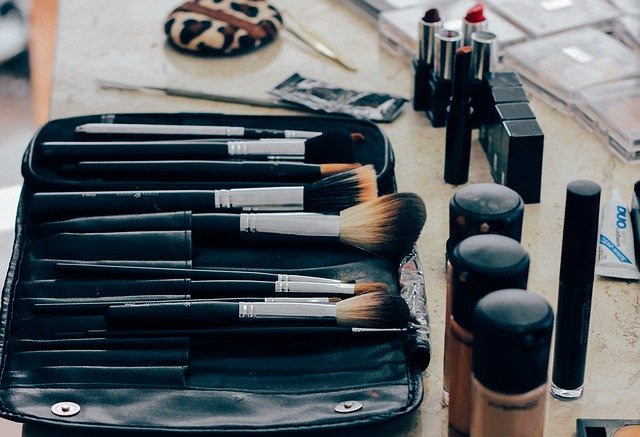What Was The First Makeup Made What 2001 Makeup
By Tim Lambert
Cosmetics in the Ancient Earth
Women take always tried to enhance their beauty. Even in Prehistoric times, people wore necklaces or bracelets made of things like shells. They also wore pendants of os or ivory. Prehistoric people may have painted or tattooed themselves. Certainly, the 'iceman' who lived in Copper-age Italy about 3,300 BCE was tattooed. Furthermore, some iron age bodies found preserved peat had manicured nails showing the upper form in Northern Europe at that time were particular about their appearance.
Farther S all the ancient civilizations used cosmetics. In Republic of iraq in 2,000 BCE perfumes were commonly used. So were pigmenting for the optics and lips. They were fabricated from various minerals and were stored in shells.
The Egyptians are known for their cleanliness (they bathed frequently) and they used many cosmetics. They used black eyeliner and green pigment for their eyelids. They as well used rouge for their cheeks. The Egyptians as well used perfume.
The Greeks as well used perfume and they used white lead to requite themselves pale complexions. They as well used rouge. Roman women also used cosmetics such every bit middle shadow. Greek women were too known for their elaborate hairstyles. Women dyed their hair and sometimes used wigs. Roman women as well used confront packs using ingredients like crocodile dung (if they could afford it!).
Roman women also used razors, pumice stone, tweezers, and depilatory creams to remove unwanted body hair. At that time there were no glass mirrors merely women used mirrors made of polished metal. The Romans are also known for their cleanliness. They rubbed themselves with oil and scraped information technology off with a tool called a strigil.
Cosmetics in the Middle Ages and Renaissance
In the Middle Ages, there were bathhouses in many towns where people could pay to have a bath. Furthermore in Northern Europe in the Middle Ages people took sweat baths.
In the Middle Ages, people used combs and tweezers. They also used toothpicks and mouthwashes. n Medieval women curled their hair with hot tongs. They besides dyed their hair. They used vegetable dyes to redden their faces and color their nails. Information technology was stylish for women to pluck their eyebrows.
In the 16th century, most people cared about their appearance. People carried mirrors made of glass or steel. They also carried combs and used tweezers, ear scoops, and os manicure sets. In the Summer people sometimes had a bathroom in the local river. Sometimes they heated a cauldron of water and had a strip wash. Or they could have a 'dry out launder' past rubbing themselves with clean linen.
In the later 16th century white lead was revived as a manner of getting a pale complexion. (Poor women had to work outdoors and so they were suntanned. Pale skin was a sign of wealth so it was desirable). Furthermore, at that time blonde hair was also popular and many women died their hair. Women also used ruby ocher on their cheeks. They also wore confront packs and they plucked their eyebrows. In the 17th century, fashionable women stuck blackness patches onto their faces. Sometimes they were in the shape of stars or crescent moons.
In the 17th-century people used toothpicks but in the latter function of the century, toothbrushes were introduced. (Toothbrushes came from Cathay. They were kickoff mentioned in 1498). People also made scented soaps.
In the 18th century, stake skin was still fashionable. And so were dark eyebrows. Women also still used rouge abundantly. Perfume was also common. In the early on 18th century a new smell was made in Cologne. Later in the century it became known as Eau de Cologne.
In the late 18th century a book chosen The Toilet of Flora (published in 1784) gave advice almost preparing brand-up. (The give-and-take toilet is derived from the French discussion toilette, which means little cloth. In the 17th century, information technology was a fabric encompass for a dressing table, called a toilet table. If a adult female was at her toilet it meant she was dressing and preparing her appearance. By the 19th century it was a euphemism for a sure room).
In the 18th century, some women wore false eyebrows fabricated of mouse fur. They were glued to the face.
Modern Cosmetics
The Industrial Revolution fabricated the mass production of cosmetics possible although many people continued to make cosmetics at home. However, in the 19th century, some people disapproved of women wearing makeup and it was often sold under the counter.
Meanwhile in the 19th-century soap became cheaper and towards the finish of the century, the middle class began to take bathrooms.
In the 19th-century women used lampblack equally eyeshadow. They too used rouge and at the end of 19th-century painting the lips became common. Meanwhile, zinc oxide replaced white atomic number 82 for whitening the face.
Electrolysis hair removal was invented in 1875. (Light amplification by stimulated emission of radiation hair removal was developed in the 1990s).
The brush deadening car was invented by Stonemason Pearson in 1885. That made the hairbrush cheaper. Pearson also invented a safe cushion hairbrush in 1885.
In the 19th-century toothpaste was sold in jars until 1892 when Washington Sheffield invented the collapsible toothpaste tube. Meanwhile, in 1888 the outset modern deodorant was invented. It was called Mum.
In the 20th century, the erstwhile puritanical attitude to makeup was forgotten and information technology was sold openly. With rising living standards women could afford more and more cosmetics.
Karl Nessler invented the perm in 1906. And so in 1915, Maurice Levy invented lipstick push-up sticks in tubes. The new lipstick became mutual in the 1920s. Modern mascara was invented in 1913 by a man named T L Williams.

In the late 19th century people tried making bogus eyelashes. A woman named Anna Taylor patented a way of making them. By the 1960s false eyelashes were mutual. Women have dyed their nails for centuries but modern liquid smash varnish was introduced in 1917. The French manicure was invented in 1975. Meanwhile, mod lip gloss was invented by Max Factor in 1930 and went on auction in 1932. In Ancient Egypt, rich women wore bogus nails made of ivory, bone, or gold. But mod acrylic artificial nails were invented by a homo named Fred Slack in 1954.
For centuries it was stylish for women to have stake skin but from the 1920s tans became popular. Eugene Schueller invented sunscreen in 1936. Women first began to shave under their artillery in the 1910s. They began shaving their legs in the 1920s when dresses became shorter. The get-go mod razor for women was fabricated in 1915. Dispensable razors for women followed in 1975.
The outset synthetic hair dye was invented in 1907. For centuries women used hot tongs to curl their hair simply in the 1930s permanent waves became common. Hairspray was invented in 1948. Meanwhile, in 1923 Leo Gerstenzang invented cotton swabs (cotton buds).
In the late 20th-century plastic surgery became common. The first facelift was performed in 1901. The first silicone chest implants were fitted by a surgeon in 1962. The first liposuction was performed in 1974.

Terminal revised 2022
Source: https://localhistories.org/a-history-of-cosmetics/
Posted by: jacksonsentin2001.blogspot.com

0 Response to "What Was The First Makeup Made What 2001 Makeup"
Post a Comment